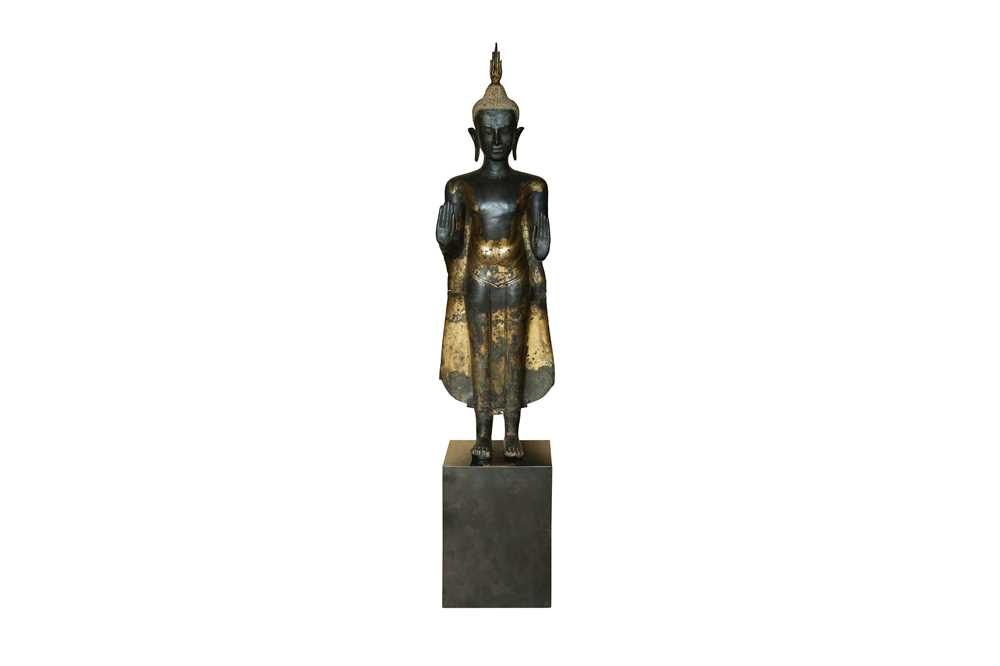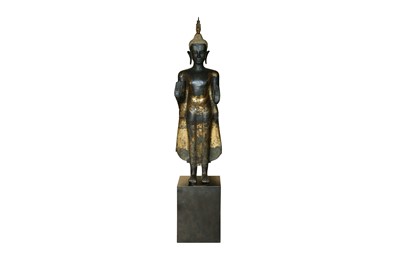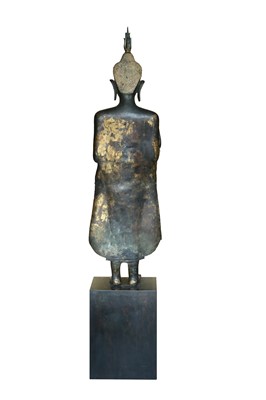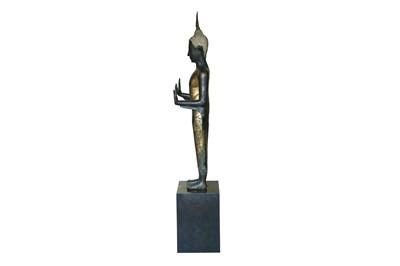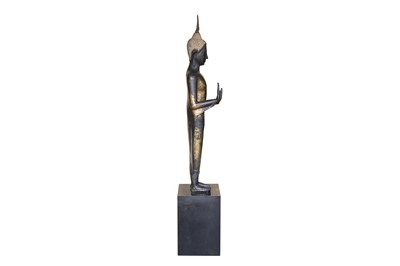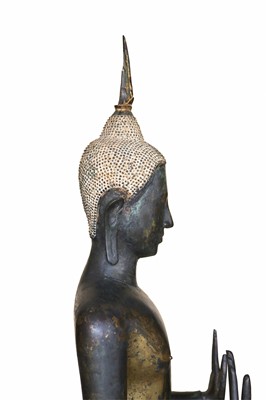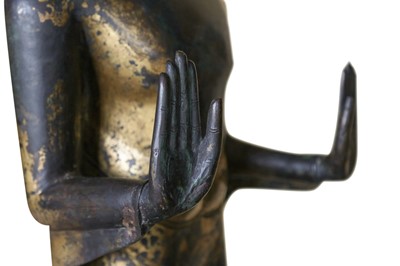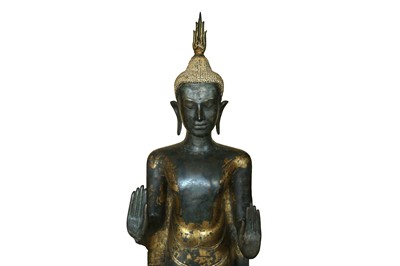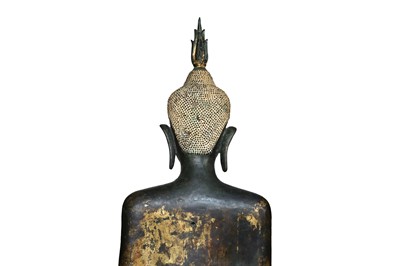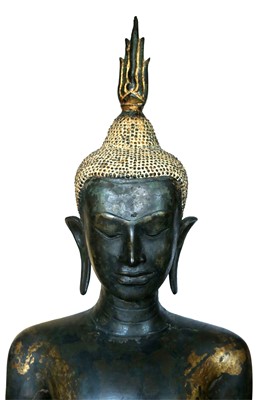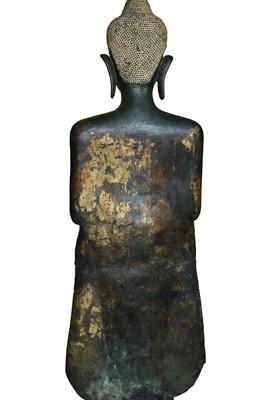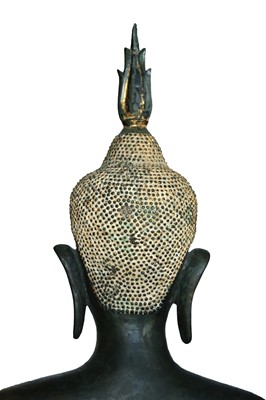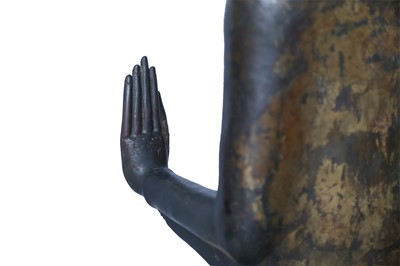29th Apr, 2022 13:00
Islamic & Indian Art
A LARGE GILT BRONZE STANDING FIGURE OF THE HISTORICAL BUDDHA, SIDDHARTHA GAUTAMA SHAKYAMUNI
U-Thong C style, Ayutthaya, Thailand, South East Asia, mid-14th – mid-15th centuries
A LARGE GILT BRONZE STANDING FIGURE OF THE HISTORICAL BUDDHA, SIDDHARTHA GAUTAMA SHAKYAMUNI
PROPERTY FROM THE LATE JEAN-PIERRE YONAN COLLECTION
U-Thong C style, Ayutthaya, Thailand, South East Asia, mid-14th – mid-15th centuries
Cast as a free-standing statue, made of gilt bronze, the preferred material in early Ayutthaya production, the historical Buddha presented standing in samabhanga (lit. without bending, the body placed upright in perfect balance representing the serenity of the soul), both hands in abhaya mudra (the Fear Not gesture), also called Calming the Ocean posture, wearing his typical diaphanous monastic attire (uttarasangha and samghati) secured by a belt around the waist, the robe clinging to the body and clearly showing the curves and nipples of the Buddha’s body, his neck marked with three lines, his face with a serene expression, downcast eyes with heavy eyelids under arched eyebrows, a content smile and full lips, elongated pierced earlobes acting as a reminder of his past as a prince wearing heavy golden jewellery, the hair arranged in small tight curls resembling 'snail curls' of Indian Gupta sculptures, on top of his ushnisha an eternal flame (rasmi), a symbol of the Buddha's spiritual radiance inspired by Sinhalese examples, mounted on a large black stand with a copper plaque at the front reading Buddha U-Thong period 14th century, 184cm high, 137cm high excluding the base.
Provenance: In the private collection of Jean-Pierre Yonan in his London flat since the 1980s.
The impressive size, accurate details, and fineness of this statue link it to the earliest phase of Ayutthaya Buddhist sculptural production in the mid to late 14th and 15th centuries, often also referred to as U Thong C period (Dorothy H. Fickle, Images of the Buddha in Thailand, 1989, p. 73).
The year 1431 marks a very important victory for the Thai people over the Khmer rulers, which is celebrated as the Siege or Fall of Angkor, a seven-month-long siege on the Khmer capital of Angkor by the Kingdom of Ayutthaya. With the rise of a new capital in 1350, Ayutthaya (Central Thailand), the Thai kingdom was fully formed and ready to be the dominant power in the region until 1767 (Ibidem, p. 72). This shift in socio-political powers was deeply felt in the arts too, where considerable changes were introduced.
Firstly, the main materials used in previous sculptural productions such as stone and terracotta were largely replaced by bronze (either plain or often gilt). Secondly, the sources of aesthetic inspiration shifted from the locally available Javanese and Khmer productions to the Indian Pala and Sinhalese canons. Indeed, Early Ayutthaya or U Thong sculptures are often characterised by a tasteful blend of Sukhothai and Khmer styles with innovative elements, leading to the creation of a brand new aesthetic. If we take our lot as an example, the gentle, oval face and elongated silhouette of our Buddha present a clear Sukhothai influence. The band framing the hairline and the engraved contour around the lips are instead typically featured in Khmer sculptures. In terms of innovation, one can admire the flame-like element on top of the Buddha’s cranial protuberance (ushnisha), also called rasmi, a symbol of spiritual radiance which, although originally inspired by Sinhalese examples, in the Thai U Thong artistic creations it developed and transformed into a unique form of a flaming conch-shell. In this period, the Buddha's hands and fingers became much more elongated and mudras were revisited, introducing original solutions like the Calming the Ocean gesture (both hands in abhaya mudra), which appears to have been very popular at the time (Gilles Beguin, Buddhist Art: An Historical and Cultural Journey, 2009, p. 186).
A similar but later and smaller standing Ayutthaya bronze Buddha figure was successfully sold in the Dani & Anna Ghigo Collection at Christie's London in 2016 (Christie's London, 12 May 2016, lot 213). Our example, however, presents much larger dimensions and the aging of the bronze suggests an earlier date, similarly to another 15th-century Ayutthaya bronze head sold at Christie's New York (21 March 2007, lot 304).
Dimensions: 184cm high, 137cm high excluding the base
Sold for £7,500
Includes Buyer's Premium
Do you have an item similar to the item above? If so please click the link below to request a free online valuation through our website.
